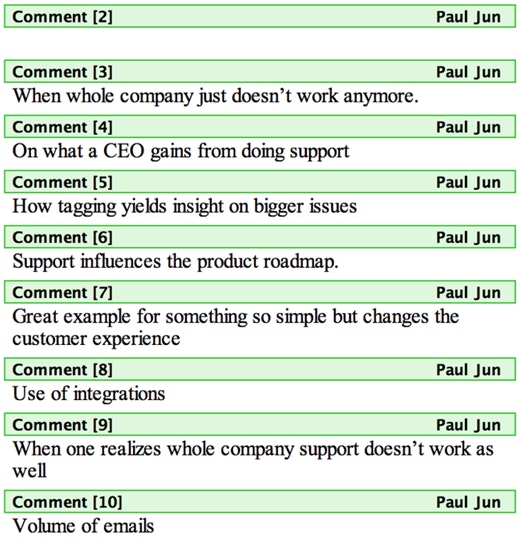A company should be proud of their services, but even more so when their customer’s lives are better because of it. That’s why many companies, in all sorts of industries, highlight their customers online. Telling these stories reflects your brand image and the kind of customers you serve.
Almost a year ago, the marketing team at Help Scout started a project called Customer Spotlights.
We were thinking of ways to get our customers involved, and realized that telling their stories could be a win-win idea, for us and for them. Our customers have stories worth telling, so we simply handed them the microphone and turned up the lights on the stage.
The goal was to seek out and understand the unique strategies our customers use to reach inbox zero or gather feedback from their customers. Luckily for us, they’ve been keen to share.
With 12 spotlights shipped, we’ve learned a lot along the way—lessons any company that spotlights their customers can relate to. I’ll take you through my process in writing these spotlights and reveal our new focus moving forward.
Customer Spotlight 1.0
At the beginning of this project, I asked our support team for standout recommendations—perhaps a support team lead who was passionate about his or her work. Once I had a list of names, I began getting in touch. I was conscious of the kind of companies I was interviewing, making sure I didn’t miss any industries.
The outreach was straightforward: email the recommended person, share what the spotlight is for, and schedule a call.
The focus was initially broad, trying to encompass all of their support tactics instead of honing in on one unique angle. I asked questions about hiring and culture, and then transitioned into the nitty-gritty of how they used tags, reports, Workflows, etc. We’ll talk more about this later.
When the transcription of the interview was done, I highlighted the responses and categorized them based on the themes I saw. This allowed me to get a greater scope of what our conversation entailed—was there a focus on hiring, culture, or the use of integrations? A mixture of two or three?

Categories created based on the final result of the interview transcript
I didn’t include every idea in the spotlight; I focused on a handful that seemed to be the most practical, unique, and connected to a bigger picture.
The spotlight I wrote about Customer.io, is a solid example. The three immediate takeaways were: they did whole-company support, had a meticulous onboarding process for new hires, and they proactively engaged with their customers. I also learned about their culture, their growth year after year, and overall philosophy for why support was central to their work.
Big Lessons Learned
Speaking to different people in various positions within these companies, I was able to gather meaningful feedback and pass it along to our team. I also learned about how different kinds of companies use Help Scout in a multitude of ways.
Over time, however, the spotlight series felt like it was losing momentum. The process needed a refresher, so, we temporarily pulled the e-brake on spotlights. We got out of the car, examined all the moving parts, learned what was missing, and started planning the next destination.
Here are a few things we learned:
Repeatable, not repetitive: Because I stuck to a fixed system for every spotlight, I began to notice—a little too late—that the write-ups were getting repetitive. It’s not that these companies didn’t have anything worthwhile to say; I wasn’t asking the right questions to draw out their best material.
To assume that a similar set of themes are applicable to every company is laziness. It’s like a reporter using the same questions for the President, a professional athlete, and a middle school spelling bee champion.
Questions should be tailored to the company and what they do best.
Specific vs. general: Customer-support teams want practical ideas on doing better work. We realized that spotlights could improve by focusing on one powerful and unique observation. An entire article on using tags or reports is more immediately helpful than lightly touching on a topic and then moving onto the next.
Speaking to customers: On a positive note, in interviewing founders, heads of support, and people on dedicated support teams, I learned a ton about the industry and our product. If you want to begin telling your own customers’ stories, I assure you these conversations will yield greater insights into your work, your company, and customers.
Moving Forward: Customer Spotlight 2.0
With a newfound focus on telling impactful customer stories with clear takeaways, here’s how we’re improving our process.
Identifying the purpose: This is a question worth answering before writing any blog post or starting a new project. If you don’t know what it’s for, then you don’t know what (or who) you’re trying to change.
What is the purpose of a spotlight? Fundamentally, they’re about showing candid, real-world examples that prove our product can solve your customer-support woes. But they’re not entirely self-serving. We put a concerted effort toward providing practical advice that readers can apply to their work.
Support is a topic best learned by example, and these spotlights must serve as examples worth emulating.
A pre-interview inquiry: The pre-interview will help us understand, up front, if there’s a unique angle to cover or if we’re heading into familiar territory. Once eyebrows are raised, we’ll move to a short phone call to get a deeper look into the processes and outcomes. This ensures that we’re using everyone’s time wisely and we walk away with something of great value.
Pacing ourselves: When I first started doing customer spotlights, I was cranking out three or four a month. It was fun talking to so many people doing great work, but it took time away from writing other essays on culture or growth. Now, we’re aiming for one solid spotlight a month.
Asking better questions: When I first started this project, I took a course on CreativeLive by Alex Blumberg, an award-winning reporter and producer for This American Life and co-host of NPR’s Planet Money. I wish I’d taken that course twice, because he admonished the one thing I failed to do: find the hook and dig in.
I realized that when I asked about tags or reports or hiring, I merely scratched the surface. When I study my transcripts now, I know I could have asked three or four more questions to dig in deeper. If the interviewee didn’t have anything more to share, I could have easily moved onto the next theme and dug in some more.
No matter the story you’re telling, asking better questions is about unearthing insights that may seem common to the interviewee, but in essence, it’s magical for the audience. It’s better to ask and find out that it was or wasn’t special, than to not know at all.
Trying to imagine what next year looks like, I see Help Scout continuing to build an evergreen archive of the best support practices and philosophies. I see stories of companies being vulnerable in their methodologies, showing that support can be done empathetically and humanely.
My hope is that you’ll consider telling your customers’ stories, too. I hope you’ll look at our experience and learn from what we could have done better, but more importantly, what we got right.







